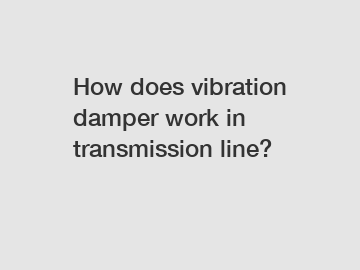How does vibration damper work in transmission line?
How Does a Vibration Damper Work in a Transmission Line?
Vibration dampers play a crucial role in preventing excessive oscillation and controlling the vibrations that occur in transmission lines. But how exactly do these dampers work? In this article, we will explore the functionality of vibration dampers, their importance in transmission lines, and their various types.
Transmission lines are designed to carry electrical power over long distances. However, wind, ice, and even electromagnetic forces can cause these lines to vibrate. This vibration, if left uncontrolled, can lead to structural damage, reduced transmission efficiency, and even power outages. This is where vibration dampers come into the picture.

The primary purpose of a vibration damper is to dissipate the energy generated by the oscillatory motion of the transmission lines. Here are some key points to consider when discussing how a vibration damper works:
1. Energy Dissipation: Vibration dampers are typically installed at specific intervals along the transmission lines. These dampers consist of a mass attached to a viscous or elastomeric material. When the transmission line vibrates, the dampers absorb the kinetic energy of the oscillation by converting it into thermal energy through the internal friction of the damping material.
2. Damping Mechanisms: Vibration dampers operate on two main damping mechanisms: viscous and elastomeric damping. Viscous dampers utilize a viscous liquid or gel-like substance that offers resistance to the motion of the damper. Elastomeric dampers, on the other hand, employ a rubber-like material that deforms under stress to dissipate the energy. Both mechanisms effectively reduce vibrations but may be more suitable for different types of transmission lines or environmental conditions.
3. Damper Design: The design of a vibration damper plays a critical role in its effectiveness. Factors such as the mass of the damper, the stiffness or compliance of the material, and the geometry of the attachment mechanism influence its damping capabilities. Proper design ensures that the damper resonates with the frequency of the transmission line vibration, maximizing energy dissipation.
4. Types of Dampers: There are several types of vibration dampers used in transmission lines, including Stockbridge dampers, spacer dampers, and spiral vibration dampers. Stockbridge dampers consist of a steel cable attached to the transmission line, which connects to a metal weight suspended between two vibration-absorbing disks. Spacer dampers are elongated devices installed between the conductors, providing resistance to the transmission line's motion. Spiral vibration dampers utilize a helical shape combined with elastomeric materials to provide dampening characteristics.
In conclusion, vibration dampers play a vital role in mitigating the vibrations occurring in transmission lines. By dissipating the energy generated by these oscillations, they prevent structural damage, increase the lifespan of the transmission line, and ensure uninterrupted power supply. Understanding the mechanisms behind their functionality, including energy dissipation, damping mechanisms, damper design, and the different types available, allows for an optimized design and selection of vibration dampers for specific transmission line requirements. So, the next time you see a transmission line, you can appreciate the important role that vibration dampers play in keeping our power grids stable and secure.
Are you interested in learning more about Down Lead Clamp For OPGW, adss suspension clamp wholesaler, cable suspension clamp? Contact us today to secure an expert consultation!

Comments